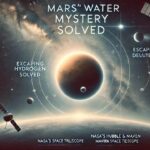NASA, JAXA, LRO, SLIM lander, Moon exploration, lunar retroreflector, laser communication, lunar orbit, space collaboration, Artemis program, lunar missions, space technology, international space cooperation, lunar research, Moon landing
Discover how NASA’s Lunar Reconnaissance Orbiter (LRO) and JAXA’s SLIM lander achieved a groundbreaking milestone by successfully bouncing a laser beam between the Moon’s surface and lunar orbit. This technological feat highlights the resilience of retroreflectors and the importance of international collaboration in space exploration.

NASA, JAXA Bounce Laser Beam Between Moon’s Surface and Lunar Orbit
In a landmark achievement, NASA’s Lunar Reconnaissance Orbiter (LRO) successfully transmitted a laser pulse to a retroreflector on Japan Aerospace Exploration Agency’s (JAXA) SLIM lander on the Moon, receiving a return signal. This event marks a significant milestone in lunar exploration and the collaboration between international space agencies.
Background and Context
NASA’s LRO has been orbiting the Moon since its launch on June 18, 2009. Equipped with seven powerful instruments, the LRO has collected extensive data, significantly enhancing our understanding of the Moon. One of its key instruments is the laser altimeter, designed to map the Moon’s topography to aid future missions.
JAXA’s SLIM (Smart Lander for Investigating Moon) touched down on the Moon’s surface on January 20, 2024. Among the equipment aboard SLIM was a Laser Retroreflector Array, a device critical for this laser communication experiment. Retroreflectors, typically mounted on the top of landers, reflect laser beams back to their source, aiding in precise measurements and navigational support.
The Laser Transmission Experiment
On May 24, 2024, during two successive orbits, the LRO passed 44 miles above SLIM and pinged the lander with its laser altimeter. Remarkably, the signal bounced back to LRO’s detector, a feat accomplished despite the suboptimal positioning of the retroreflector on SLIM.
Retroreflectors are usually positioned on the top of landers to provide a wide range of angles for laser beams to hit and return. However, SLIM’s retroreflector was facing sideways, significantly narrowing the range and complicating the task for LRO. To overcome this challenge, the LRO team collaborated with JAXA to pinpoint SLIM’s exact location and orientation on the Moon’s surface.
The successful transmission and reception of the laser signal were attributed to meticulous planning and the resilient design of the retroreflectors. “For the LRO team to have reached a retroreflector that faces sideways, instead of the sky, shows that these little devices are incredibly resilient,” said Xiaoli Sun, who led the team that built SLIM’s retroreflector at NASA’s Goddard Space Flight Center in Greenbelt, Maryland.
Significance of the Achievement
This successful laser communication experiment between LRO and SLIM underscores the durability and reliability of retroreflectors in harsh lunar environments. These devices, which require no power or maintenance, can last for decades on the Moon’s surface, providing continuous support for future missions.
Retroreflectors serve various purposes. They can act as beacons for guiding Artemis astronauts to the lunar surface, especially in the dark. They can also mark the locations of spacecraft already on the Moon, aiding both crewed and uncrewed missions in precise landing operations.
The recent experiment with SLIM was not the first of its kind. On December 12, 2023, LRO transmitted a laser beam to a NASA retroreflector aboard ISRO’s (Indian Space Research Organisation) Vikram lander, successfully receiving a return signal. Since then, LRO has exchanged laser pings with Vikram three more times, demonstrating the potential of this technology for reliable communication and navigation on the Moon.
The Technical Details
The retroreflector used in these experiments is a compact device featuring eight quartz corner-cube prisms set into a dome-shaped aluminum frame, measuring just 2 inches wide. Despite its small size, the retroreflector can reflect laser beams over vast distances, enabling precise measurements and communications.
LRO’s laser altimeter, although not originally designed for targeting retroreflectors, has proven capable of pinpointing these small devices on the Moon’s surface. Each successful ping represents a significant technical achievement, requiring LRO to aim within 1/100th of a degree of the retroreflector’s location.
The ability to transmit and receive laser signals over such distances and with such precision highlights the advanced engineering and technological capabilities of NASA and its international partners. These achievements pave the way for more sophisticated lunar exploration missions and deeper collaboration between space agencies.
Future Implications and Opportunities
The success of this laser communication experiment opens up numerous possibilities for future lunar missions. As NASA and its commercial and international partners prepare to return to the Moon, the presence of durable and reliable retroreflectors will be invaluable.
These devices can assist in a range of activities, from navigation and landing operations to scientific experiments and data collection. For instance, retroreflectors can help track the precise movements of the Moon, improving our understanding of its geophysical properties and evolution.
Moreover, the ability to establish reliable communication links between orbiters and landers enhances the overall efficiency and safety of lunar missions. This technology can also be adapted for other planetary bodies, expanding its potential applications beyond the Moon.
NASA’s ongoing collaboration with international partners like JAXA and ISRO exemplifies the importance of global cooperation in space exploration. By sharing knowledge, resources, and expertise, these collaborations can accelerate the pace of discovery and innovation, benefiting all of humanity.
Conclusion
The successful bouncing of a laser beam between NASA’s LRO and JAXA’s SLIM lander represents a remarkable achievement in lunar exploration. This experiment not only demonstrates the resilience and reliability of retroreflectors but also underscores the value of international collaboration in advancing space science and technology.
As NASA, JAXA, and other space agencies continue to push the boundaries of exploration, such technological milestones will play a crucial role in shaping the future of space travel. The insights gained from these experiments will inform the design and execution of upcoming missions, bringing us closer to a sustainable and expanded human presence on the Moon and beyond.
Read More
- The ChatGPT is an artificial intelligence language model developed by OpenAI for natural language processing tasks
- ChatGPT future versions to replace many human tasks: Top AI Scientis
- NASA Releases Groundbreaking 2024 Civil Space Shortfall Ranking
- NASA Postpones Spacewalk Outside ISS Due to Spacesuit Discomfort Issue: What’s Next?










